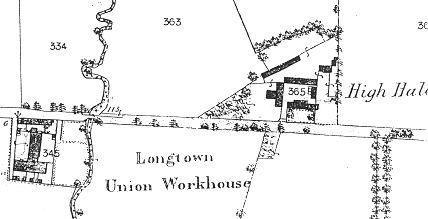Longtown, Cumberland
Up to 1834
A parliamentary report of 1777 recorded local workhouses in operation in Arthuret (for up to 50 inmates), Bewcastle (25), Kirkandrew—Middle Quarter (50), Kirkandrew—Mote Quarter (50), Kirkandrew—Nether Quarter (45), Kirkandrew—Nichol Forest Quarter (50), Kirklinton—Hethersgill Quarter (20), Kirklinton—Middle Quarter (20), Kirklinton—Westlinton Quarter (20), Stapleton—Stapleton Quarter (20), and Stapleton—Trough Quarter (3).
In 1821, the parish of Arthuret erected a workhouse two miles to the east of Longtown. It accommodated about 130 inmates.
After 1834
Longtown Poor Law Union formally came into being on 19th June 1837. Its operation was overseen by an elected Board of Guardians, 18 in number, representing its 14 constituent parishes and townships as listed below (figures in brackets indicate numbers of Guardians where not one):
Cumberland: Arthuret (3), Belbank, Bewcastle, Hethersgill (2), Kirkandrews—Middle Quarter, Kirkandrews—Nether Quarter, Kirkandrews Moat, Kirklinton—Middle, Nichol Forest (2), East and West Scaleby, Solport Quarter, Stapleton, Trough, West Linton.
The population falling within the union at the 1831 census had been 26,906 with parishes and townships ranging in size from Trough (population 169) to Arthuret (2,903). The average annual poor-rate expenditure for the period 1834-36 had been £2,848 or 6s.3d. per head of the population.
In 1837, the union acquired the existing Arthuret parish workhouse and extended it, at a total cost of around £3,000, to house up to 130. The workhouse location and layout can be seen on the 1860s map below.

Longtown workhouse site, 1863
It comprised an entrance block facing onto the road at the north, with an inverted T-shaped main block to the rear. A school-room could hold up to 30 children.
Water was supplied by a pump in the kitchen supplemented by water from a stream adjoining the premises. The six acres of grounds around the buildings were cultivated by the inmates.
An official inspection of the building in 1866 recorded that:
The bedsteads are nearly all of wood, and if the house were full, the inmates would sleep two in a bed. The beds and bedding are clean, the chaff with which the former are stuffed is renewed once or twice it year.
The classification, as previously observed, is imperfect. The authorised number of inmates is 130, but they rarely exceed 70 or 75. Their diet, clothing, employment, recreation, and medical attendance I believe to be properly attended to, and satisfactory.
The sick are attended by two pauper nurses, who sleep in the same room with the patients.
There is a paid chaplain, but every license is given the inmates as to attendance on their own ministers. The master states he sends for any minister whose presence may be desired by an inmate.
There are generally from 20 to 30 boys and girls in school, who are fairly educated and industrially trained; the boys by digging in the garden, and the girls in sewing, knitting, and other household duties.
No great improvement can be carried out with the present building. The Guardians have from time to time acquiesced in various details for this object, and I do not advise further alteration. A new house on a site nearer the centre of the union would be the most desirable measure.
After 1930, the site became the Longtown Public Assistance Institution, catering for the elderly and chronic sick. The buildings are believed to have been demolished in the 1950s.
Staff
- 1881 Census
- 1914 — Master: T Staniland; Matron: Mrs Eliza Staniland.
Inmates
Records
Note: many repositories impose a closure period of up to 100 years for records identifying individuals. Before travelling a long distance, always check that the records you want to consult will be available.
- Carlisle Archive Centre, Lady Gillford's House, Petteril Bank Road, Carlisle CA1 3AJ. Holdings include: Guardians' minutes (1913-30); Miscellaneous papers (1787-1895); etc.
Bibliography
- RN Thompson (1978) The Working of the Poor Law Amendment Act in Cumbria, 1836-1871 in Northern History, Vol XIV.
Links
- None.
Unless otherwise indicated, this page () is copyright Peter Higginbotham. Contents may not be reproduced without permission.


